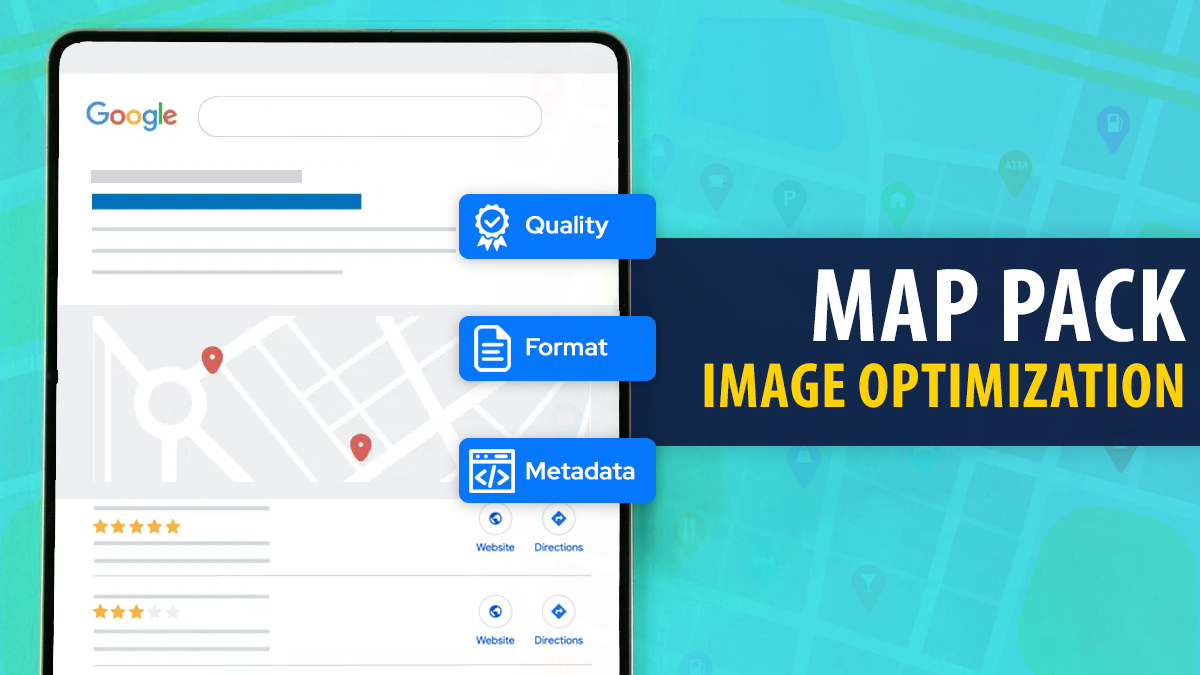In the local search competition, businesses need to use every tool they can to be noticed. One important thing that people often forget is how images can affect where businesses show up in Google Maps’ local search results.
Good images can greatly improve a business’s presence on the internet, bringing in more clicks and interest from potential customers. Choosing the right image formats helps the pages load faster and makes it easier for users, which Google really cares about.
By improving the quality of their images, choosing the right format, and using helpful information, businesses can get more chances of showing up in local search results. In this post, we will look in detail at the role of map pack image optimization.
The Role of Map Pack Image Optimization
Improves Visual Appeal
High-quality images make your Google Business Profile look much better, attracting more potential customers. When people look for nearby businesses, attractive pictures can catch their eyes and make them want to click on your profile.
This visual appeal can encourage users to interact more, like visiting your website or calling your business. Using attractive and relevant pictures makes it more likely that people will choose your business instead of others.
Google favors profiles that get more interaction, which can help get better rankings in search results locally. Also, good pictures can show special features of your business, leaving a lasting impression that makes people want to come back and tell their friends.
Top Google Maps SEO marketing services specialize in optimizing Map Pack images by enhancing quality, format, and metadata to improve visibility and drive local engagement.
Makes User Experience Better
Images are very important for making user experience better because they give clear visual information. Good photos help people see what your business is like, whether it’s the feel of your restaurant, how professional your services are, or the quality of your products.
Clear and helpful images can lessen confusion and create trust with possible customers. A good collection of images can help users make decisions, which makes them more happy and likely to buy. This can lead to enhanced 3-Pack ranking strategies.
Google likes businesses that provide a great experience for users. Also, interesting pictures and videos can make people stay on your profile longer, which makes them more likely to do things like book a reservation or visit you in person.
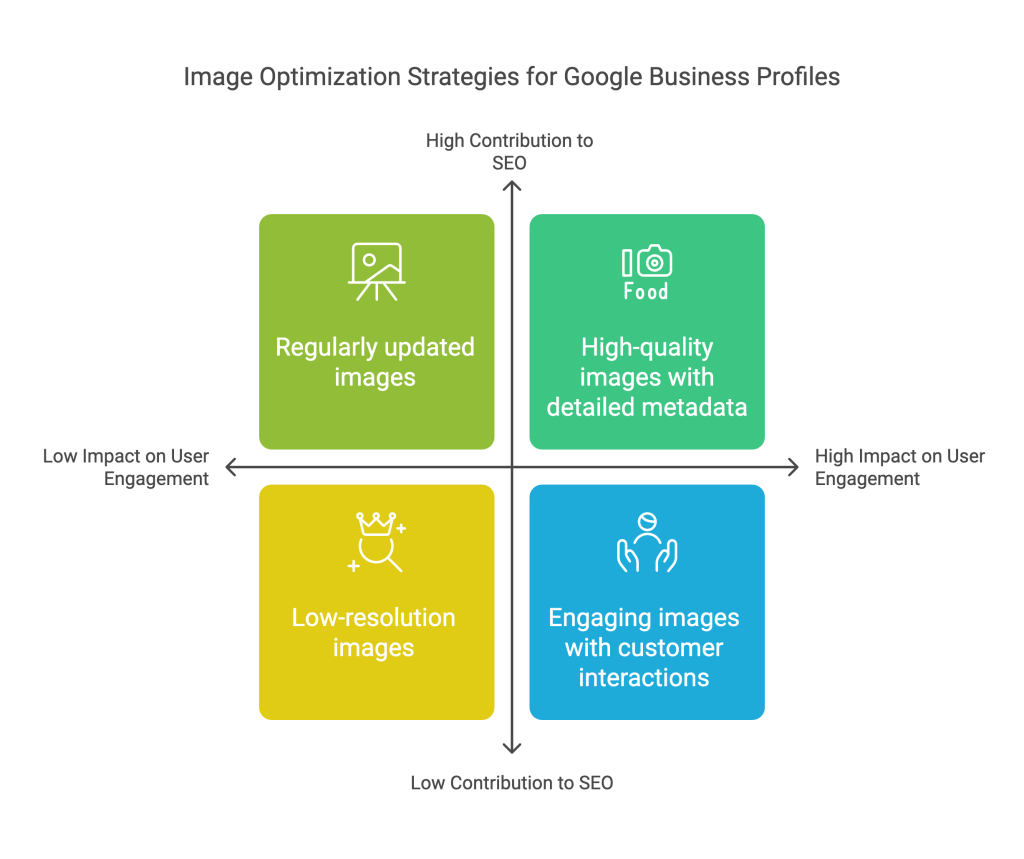
Boosts Local SEO Rankings
Images help your local SEO rankings by showing search engines that your business is relevant and good quality. Google likes profiles that have good and relevant pictures because it helps make the user experience better.
By regularly updating your pictures and keeping your profile looking nice, you boost your chances of showing up in the important local listings, which brings more visitors to your business.
Regular updates and good quality pictures show Google that your business is active and involved, which helps your SEO ranking. This can help you rank better, which makes it easier for customers to find and pick your business instead of others.
Builds Trust
Using high-quality images helps people trust your business and see it as professional and genuine. Visitors are more likely to trust a business that shares honest and clear pictures of what it sells.
It can help customers feel confident that what they see online is the same as what they will experience in person. Being honest helps build a good reputation and makes people more likely to interact with your business, resulting in more sales and loyal customers.
Trust is important for long-term success, and good quality images help create them. Having good image galleries shows that you care about quality and making customers happy, which helps strengthen your reputation as a trustworthy business.
Images play a crucial role in Local Pack vs Organic Results by driving user engagement directly in map-based searches for the Local Pack, while enhancing click-through rates in Organic Results.
Encourages Customer Interaction
Images can motivate customers to write reviews and engage with your business profile. People are more likely to share their stories and pictures when they see a neat and good-looking profile.
Good reviews from customers help show that you are trustworthy and make your business more appealing to new customers. This connection can help build a community and get more people interested, making your profile more visible in local searches.
More people engaging with your business shows Google that it’s popular and important, which could help your ranking. Also, responding to customer reviews and pictures shows that you care about what they think, which helps build better relationships and loyalty.
The Importance of Image Quality
Good image quality is very important for building a strong online presence for businesses that want to get noticed on platforms like Google Maps. Good images not only attract possible customers but also show that you are professional and reliable.
Bright, clear, and high-quality photos can really make the experience better for users by showing genuine pictures of products, services, or places. This amount of detail helps potential customers make smart choices, boosting their trust in choosing your business.
Google likes profiles that have clear, good-quality pictures because they improve the user experience. This can help your chances of showing up higher in local search results. Blurry, dark, or low-quality pictures can turn people away and hurt your business’s online image.
Using good pictures shows that you care about quality and keeping your customers happy. This leads to more people interacting with your profile. Better picture quality can bring more people to your business, keep customers coming back, and help you stand out from others in your area.
Best Image Formats for SEO
JPEG
JPEG is a well known image format that can make big pictures smaller in size without losing much quality. This format is great for photos and detailed images that have lots of colors and shades.
When JPEG images are smaller in size, they open more quickly, making websites work better and helping users have a good experience. Quicker loading times help keep visitors on your site longer and make them more interested, which tells search engines that your site is enjoyable to use.
It’s important to find a good balance between file size and picture quality so that images don’t look too blurry or pixelated. Regularly updating and improving JPEG images helps keep them useful and in line with SEO rules.
PNG
PNG (Portable Network Graphics) is a type of image file that retains the same quality even after being made smaller in size. This makes PNG great for images that need to be clear and detailed, like logos, icons, and pictures with words.
Also, PNG files can have clear backgrounds, which makes them useful for different design projects. PNG files are usually bigger than JPEGs, but it’s important to make them smaller for quicker loading to help with SEO.
Good PNG images make your online appearance look professional and clean, helping to build trust in your brand. By keeping a good balance between how nice your pictures look and their size, you can use PNG images to help your website’s SEO and make it run better.
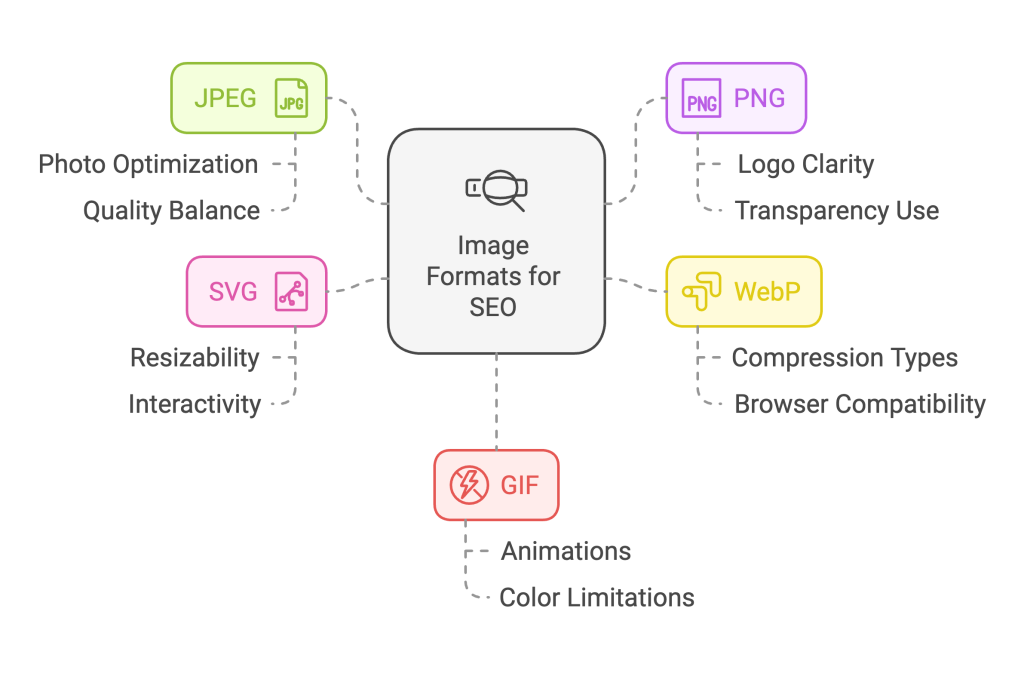
WebP
WebP is a new type of image created by Google. It makes pictures smaller in size while keeping good quality, better than JPEG and PNG. WebP supports two types of image compression, which help reduce file sizes while keeping good image quality.
This makes web pages load faster and improves user experience. Faster loading times are important for SEO because they keep people on your site longer and make them more interested. Using WebP images can make your website work better by saving data and making pages load faster.
It’s important to give alternative options for browsers that don’t support WebP so that everyone can see your content. Using WebP can help you optimize the size of your images, which makes your website faster and improves your search engine rankings.
SVG
SVG (Scalable Vector Graphics) is a type of image format that uses vectors instead of pixels. It is great because you can make it bigger or smaller without losing quality, which makes it perfect for things like logos, icons, and other graphics.
Unlike raster images, SVGs can be resized without losing quality, so they always look clear on any device or screen size. This format allows for interactivity and animations, making the website more engaging and visually appealing.
These files are usually smaller than raster images, which means they load faster and make websites work better. Using SVG for images helps keep your website looking good and working well on different devices.
GIF
GIF (Graphics Interchange Format) is used for simple animations and pictures with a small number of colors. GIFs are not good for photos because they have a limited range of colors, but they are great for making fun animations and small images.
Animated GIFs can make your website more lively and interesting, grab people’s attention, and improve the overall experience for visitors. However, GIF files can be big, so it’s important to make them smaller to prevent slow loading times.
By using GIFs carefully and making sure they are small in size, you can keep things looking good while also making sure the performance is smooth. Well-optimized GIFs can make your content better, help users interact more, and create a more interesting website.
The Importance of Image Metadata
How Search Engines Understand
Image information, like EXIF data, is important for helping search engines know what an image is about. This metadata can include information such as the camera settings, when the photo was taken, and where it was taken.
By adding this information, you help search engines understand your images better, so they can find and rank them correctly. For example, adding images to your business’s location targeting can help improve rankings by showing that you are relevant to the area.
Search engines use this extra information to rank and show your images better in search results, which helps more people see them. Using metadata correctly helps search engines understand and organize your images better.
Image Management
Metadata is very helpful for keeping large image collections organized and easy to manage. By adding important words, descriptions, and categories to pictures, you help people find and get the right images more easily when they need them.
This is helpful for businesses and creators who have a lot of pictures and videos to organize. Good metadata makes it easy to find images, which helps make work easier and more efficient. For example, using metadata to sort images by project, date, or type makes it easier and faster to find them.
This helps make creating and marketing content smoother. Good image management using metadata helps your team work better and makes sure your images are easy to find for marketing and promotions. This supports a clear and organized content strategy.
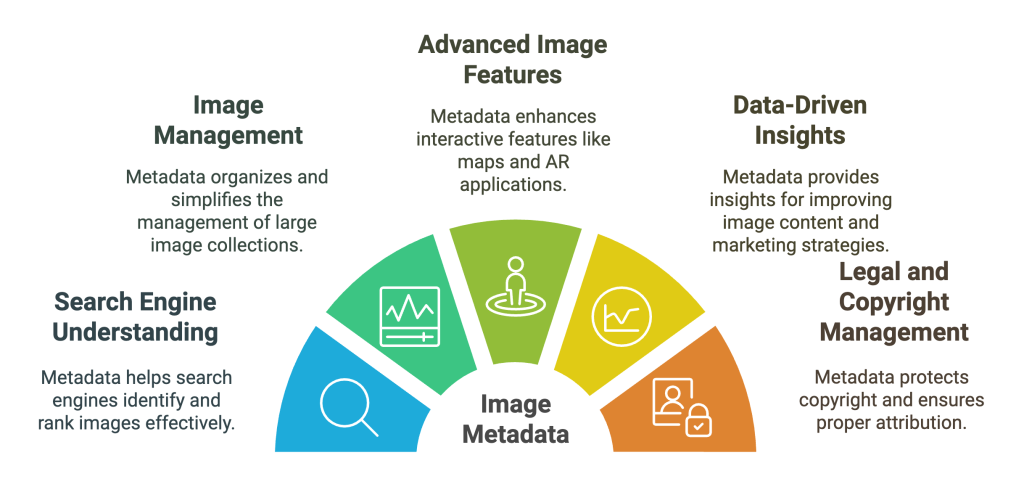
Advanced Image Features
Metadata helps improve image functions and features, like interactive maps and augmented reality apps. Geotagged images can be used to make interactive maps that show where businesses are or highlight travel experiences, giving users a more interesting and enjoyable experience.
In AR apps, extra information can provide users with immediate, relevant details, making images more useful and interactive. By adding clear and correct information about your files, you can use new features that help you show and use your visual content in fresh ways.
They offer special and engaging experiences that can draw in and keep users. Using extra information about data helps improve features, which makes users more interested and encourages new technology, leading to a more lively and attractive online experience.
Data-Driven Insights
Image metadata gives useful information about how well your images are doing and how they are affecting people. By looking at details like when and where pictures were taken and what camera was used, businesses can better understand which images work best.
This method uses data to help make better choices about content and marketing. For example, noticing what kinds of images or places people like can help create content that the audience will enjoy more in the future.
Also, looking at metadata can show trends that help decide when and where to place images for the best effect. Using metadata for insights helps visual content change to match business goals and what the audience likes, making marketing more effective.
Legal and Copyright Management
Metadata is important for handling legal and copyright issues related to visual content. By adding copyright info, licensing details, and creator names to image data, businesses can guard their ideas and make sure the right people get credit.
This information helps stop people from using and sharing images without permission, protecting the rights of those who created or own the images. Also, metadata can have rules about how people can legally use images.
Well-managed metadata makes sure that all legal rules are followed, which helps lower the chance of copyright problems and legal issues. By adding detailed copyright information to image data, businesses can keep control over their pictures and protect their legal rights.
Best Practices for Optimizing Images on Google Maps
Use Quality Pictures
Bright and clear images of your business look professional and attract potential customers. Good pictures can grab people’s attention and make them more interested in visiting your profile, checking out what you have to offer, and reaching out to you.
Google likes showing good-quality images in search results, which can help you rank better. Updating your pictures often to show new products or changes in your store makes your profile interesting and up-to-date.
It helps build credibility amongst users and makes them feel more confident in you. Good pictures can make your business look different from others, helping your profile get noticed in local searches and bringing more visitors to your website.
Competitive analysis is vital for Map Pack Image Optimization as it helps identify industry standards, successful strategies, and opportunities to outperform competitors in local search results.
Make Image Files Smaller
Making image files smaller is important to help web pages load quickly. This improves how users feel about the website and helps with search engine rankings. Large image files can make your website slow, which can cause more visitors to leave quickly and lower your search rankings.
Use image compression tools to make file sizes smaller without losing quality. Formats like JPEG and WebP are great for keeping a good picture quality while making the file size smaller. Also, use images that change size to fit different screens, so everything looks good on all devices.
By reducing file sizes, you make your website faster and improve user happiness, which are important for having a strong online presence. Faster loading times make it easier for people to use your website, keep them from leaving quickly, and help your site rank better on search engines.
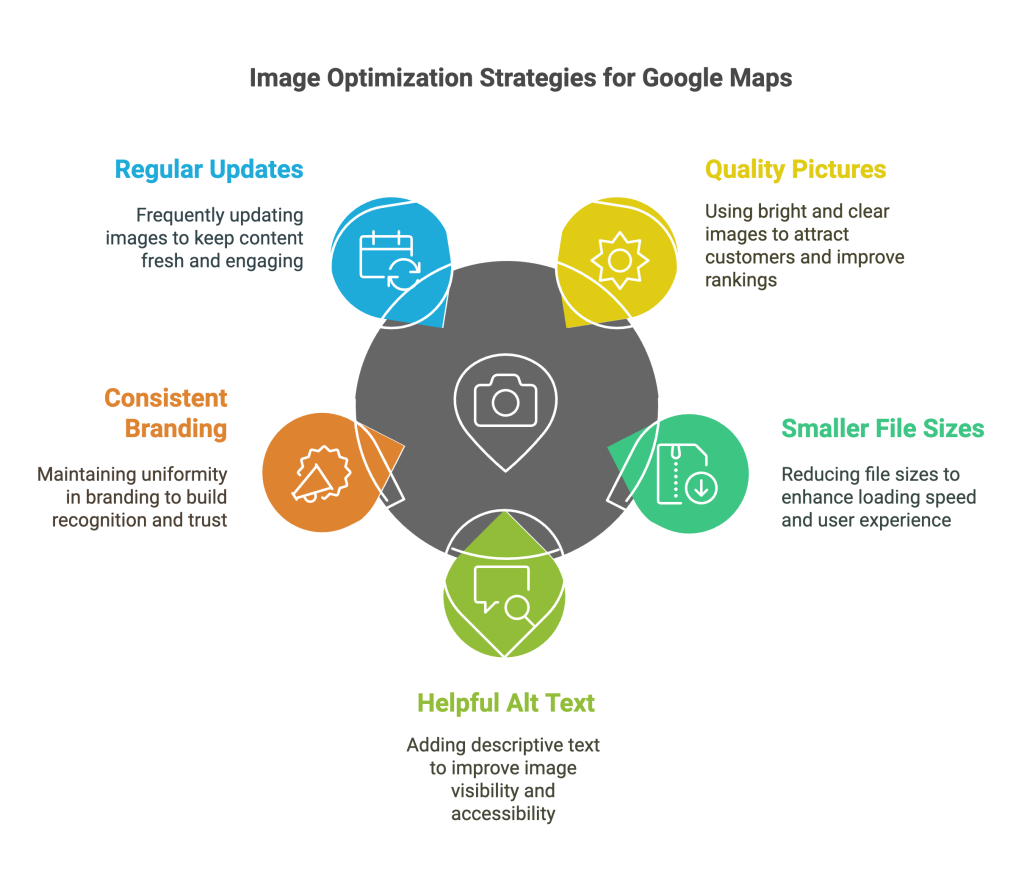
Add Helpful Alt Text
Alt text is important for optimizing images. It gives a description of images for search engines and for people who have visual impairment. Adding clear and helpful text to describe your images can boost their visibility in search results.
Alt text should clearly explain what is in the image and include important words, but don’t use too many. This practice makes it easier for everyone to see your images and helps improve your website’s search ranking.
Using good alt text helps search engines know what your images are about. Also, alt text makes your website easier for everyone to use, especially for people with vision problems who use screen readers to browse the internet.
Have a Consistent Branding
Consistent branding on all your images on Google Maps helps make your business look unified and easy to recognize. Use your logo, colors, and style in all pictures to strengthen your brand. Being consistent helps people trust your business and makes it easier for them to remember you.
Make sure all pictures show what your brand stands for and the message you want to share, creating a consistent look. Having a consistent brand helps search engines link your images to your business, making it easier for people to find you in search results.
Keeping a clear and consistent visual look helps strengthen your brand’s presence and trustworthiness online. By looking professional and reliable, you can get more customers, make them stick with your brand, and stand out from other businesses.
Regularly Update Images
Keep your images fresh and updated. It’s important for having an active and interesting Google Maps profile. Updating your pictures often to show new products, seasonal changes, and special events keeps your profile interesting and attractive.
New pictures show search engines and people that your business is active and involved. Think about sharing different parts of your business, like how you interact with customers, photos from behind the scenes, and any new products you have.
Regular updates keep users interested and make your profile more appealing. Updating your images regularly can keep your audience interested, make them come back, and help your online presence overall. It can also provide them with the latest deals you can offer.
To Conclude
Optimizing your image quality, format, and metadata is very important for boosting your business’s ranking in Google Maps local search results. Good quality images get more people interested in your business and help it look more professional and reliable.
Using the right image formats like JPEG or WebP helps images load faster, making it better for users and improving search engine results. Adding important information, like alt text and geotags, helps search engines understand your images better.
This makes it easier for them to find and show your images in local searches. By paying attention to these things, you increase your chances of showing up in local searches and make your profile more interesting and easy for potential customers to use.
FAQs
Why should you use geotagged images?
Geotagged images have location information that helps Google know where your business is located. This information is important for local SEO because it links your images to where you are located. When people look for businesses close to them, pictures with location tags can help you show up in local search results. Geotagging helps your business show up in local searches, making it easier for people nearby to find you.
How often should you update pictures on Google Maps?
Updating your pictures regularly makes your Google Business Profile interesting and up-to-date. It shows Google that your business is running, which can help improve your rankings. New pictures show what your business looks like now, so customers can see what you really offer. Try to update your images regularly, especially when there are big changes to your products, services, or location.
What kinds of pictures can be used on Google Maps profile?
Businesses can add different types of pictures that highlight what they offer, like photos of their products, pictures of the inside and outside of their location, and images of their staff and customers. Good pictures of your products and services help customers see what they can expect, and pictures of your place make it easier for them to find you. Adding pictures that show what makes your business special can make your profile more attractive and helpful.
How does the size of image files impact user experience?
Big image files can make your website take longer to load, which can make users unhappy. If a website takes too long to load, people are likely to leave it. Making image files smaller helps your site load faster, which makes it easier for users and stops them from leaving your site quickly. This is important for SEO because Google looks at how fast a page loads when deciding how to rank websites.
Can pictures from customers help your Google Maps rankings?
Yes, customer pictures can improve your rankings on Google Maps. These pictures show true, everyday moments of your business, helping to build trust with new customers. Getting customers to share photos and write reviews can make them more interested in your profile. When more people interact with your business, it shows Google that your business is popular and important. This can help you rank better in local searches.
